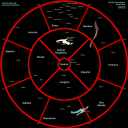Galactography
Star Charts
 The development of the Standard Galactic Star Map is yet
another one of those developments lost in the mists of time. In fact, it has only
come to light in the last hundred years how some of the Galactic Standard measures come
into being. The development of the Standard Galactic Star Map is yet
another one of those developments lost in the mists of time. In fact, it has only
come to light in the last hundred years how some of the Galactic Standard measures come
into being.
The Standard Galactic Star Map was known to be in use
during the 9th century of the Imperium, The generally accepted, 2-dimensional
representation, known as the Asimovian Projection, gives us our only clue as to its
origins. We can only assume that Asimov was some ancient galactographer who merely
copied the map from sector boundaries already in use.
Essentially, the galaxy is divided into three
concentric spheres centred on the trigonometric centre deep within the central black hole
- not surprising given the geometric sum of all gravitic forces are centred about the same
point.
The innermost sphere has a diameter of approximately
5,041 light years but contains nearly one half of the galaxy's entire mass. This
sphere encompasses a single sector known as the Central Sector but contains no inhabited
worlds, although there are several scientific bases - mostly on airless planetoids.
 The next sphere, enclosing the Central Sector, known as the
Inner Sphere, is divided eight sectors, also known as the Inner Sectors. Four above
the galactic plane of rotation and four below1. The
Inner Sphere continues outward from the Central Sector to a distance of 28,384 light years
from the galactic centre. The next sphere, enclosing the Central Sector, known as the
Inner Sphere, is divided eight sectors, also known as the Inner Sectors. Four above
the galactic plane of rotation and four below1. The
Inner Sphere continues outward from the Central Sector to a distance of 28,384 light years
from the galactic centre.
The outermost sphere encloses the Inner Sphere and
contains 16 sectors; eight above the galactic plane of rotation and eight below,
stretching right out to the edge of the Galaxy, 51,626 light years from the galactic
centre. Although each of these sectors contains a volume of space larger than the
Inner Sectors, more of the inhabited worlds lie closer to the plane of rotation of the
Galaxy than in the Inner Sectors.
Mapping the Stars
Each inhabited world orbits a star whose position is
represented in 3-dimensional space by three values; theta (Ø), rho (Þ) and delta (ð).
theta is an angular measurement
clockwise from the Galactic Meridian2 when viewed from above
the galactic plane of rotation.
rho is an angular measurement of the
star above (positive) or below (negative) the plane of rotation of the galaxy.
delta is the distance, in light years,
from the galactic centre.


1. It is difficult to talk about above
and below when the galactic centre of gravity always points toward the central
black hole. By convention, galactographers agree that you are above
the galactic plane of rotation when the galaxy appears to be rotating clockwise beneath
you. Likewise you are below the galactic plane of rotation when the
galaxy appears to be rotating anticlockwise above you. It seems unscientific to talk
of terms like beneath and above but, for the purposes of this article,
these terms will surfice. For a complete scientific discussion of galactic geometry
there are many useful studies that could be consulted, for example Sarif's "Popular
Galactography".
2. The Galactic Meridian can be
thought of as an imaginary line drawn between the galactic centre and the edge of the
galaxy. There are an infinite number of meridians that could have been chosen.
Why the current Galactic Meridian was chosen is now known to be because it bisects
the star Sol; recently discovered to be the star about which Man first evolved on the
planet Earth.
  
|